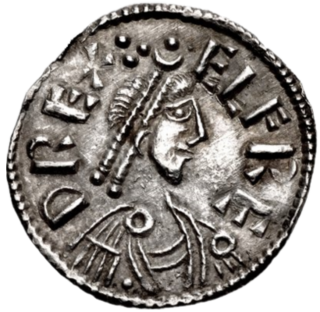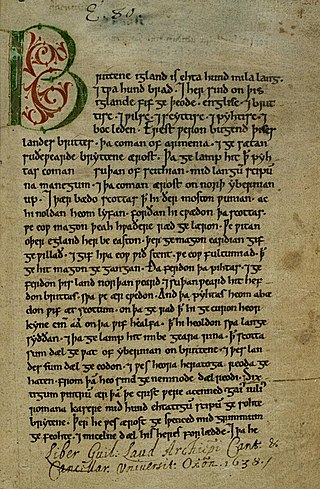
Alfred the Great was King of the West Saxons from 871 to 886, and King of the Anglo-Saxons from 886 until his death in 899. He was the youngest son of King Æthelwulf and his first wife Osburh, who both died when Alfred was young. Three of Alfred's brothers, Æthelbald, Æthelberht and Æthelred, reigned in turn before him. Under Alfred's rule, considerable administrative and military reforms were introduced, prompting lasting change in England.
Ælfheah, more commonly known today as Alphege, was an Anglo-Saxon Bishop of Winchester, later Archbishop of Canterbury. He became an anchorite before being elected abbot of Bath Abbey. His reputation for piety and sanctity led to his promotion to the episcopate and, eventually, to his becoming archbishop. Ælfheah furthered the cult of Dunstan and also encouraged learning. He was captured by Viking raiders in 1011 during the siege of Canterbury and killed by them the following year after refusing to allow himself to be ransomed. Ælfheah was canonised as a saint in 1078. Thomas Becket, a later Archbishop of Canterbury, prayed to Ælfheah just before his murder in Canterbury Cathedral in 1170.

Winchester is a cathedral city in Hampshire, England. The city lies at the heart of the wider City of Winchester, a local government district, at the western end of the South Downs National Park, on the River Itchen. It is 60 miles (97 km) south-west of London and 14 miles (23 km) from Southampton, its nearest city. At the 2021 census, the built-up area of Winchester had a population of 48,478. The wider City of Winchester district includes towns such as Alresford and Bishop's Waltham and had a population of 127,439 in 2021. Winchester is the county town of Hampshire and contains the head offices of Hampshire County Council.

Æthelbald was King of Wessex from 855 or 858 to 860. He was the second of five sons of King Æthelwulf. In 850, Æthelbald's elder brother Æthelstan defeated the Vikings in the first recorded sea battle in English history, but he is not recorded afterwards and probably died in the early 850s. The next year Æthelwulf and Æthelbald inflicted another defeat on the Vikings at the Battle of Aclea. In 855, Æthelwulf went on pilgrimage to Rome and appointed Æthelbald King of Wessex, while Æthelberht, the next oldest son, became King of Kent, which had been conquered by Wessex thirty years earlier.
Æthelweard was an ealdorman and the author of a Latin version of the Anglo-Saxon Chronicle known as the Chronicon Æthelweardi. He was a kinsman of the royal family, being a descendant of the Anglo-Saxon King Æthelred I of Wessex, the elder brother of Alfred the Great.

Swithun was an Anglo-Saxon bishop of Winchester and subsequently patron saint of Winchester Cathedral. His historical importance as bishop is overshadowed by his reputation for posthumous miracle-working. According to tradition, if it rains on Saint Swithun's bridge (Winchester) on his feast day it will continue for forty days.
Ælfthryth was Queen of the English from her marriage to King Edgar in 964 or 965 until Edgar's death in 975. She was a leading figure in the regency during the minority of her son King Æthelred the Unready between 978 and 984.
The Treaty of Wedmore is a 9th-century agreement between King Alfred the Great of Wessex and the Viking king, Guthrum the Old. The only contemporary reference to the treaty is that of a Welsh monk, Asser, in his biography of Alfred, known as Vita Ælfredi regis Angul Saxonum, or "The Life of King Alfred", in which Asser describes how after Guthrum's defeat at the Battle of Edington, followed by his surrender some days later, he agreed to a peace treaty with Alfred. The treaty was conditional on Guthrum's being baptised to endorse the agreement, as well as to allow him to rule more legitimately over his Christian vassals but to remain pagan to his pagan vassals. Also, Guthrum and his army were to leave Wessex.

Halfdan Ragnarsson was a Viking leader and a commander of the Great Heathen Army which invaded the Anglo-Saxon kingdoms of England, starting in 865.
Historians in England during the Middle Ages helped to lay the groundwork for modern historical historiography, providing vital accounts of the early history of England, Wales and Normandy, its cultures, and revelations about the historians themselves.

Æthelwold of Winchester was Bishop of Winchester from 963 to 984 and one of the leaders of the tenth-century monastic reform movement in Anglo-Saxon England.

John of Worcester was an English monk and chronicler who worked at Worcester Priory. He is now usually held to be the author of the Chronicon ex Chronicis.

The Liber Eliensis is a 12th-century English chronicle and history, written in Latin. Composed in three books, it was written at Ely Abbey on the island of Ely in the fenlands of eastern Cambridgeshire. Ely Abbey became the cathedral of a newly formed bishopric in 1109. Traditionally the author of the anonymous work has been given as Richard or Thomas, two monks at Ely, one of whom, Richard, has been identified with an official of the monastery, but some historians hold that neither Richard nor Thomas was the author.
Relatio de Standardo, or De bello standardii, is a text composed probably in 1153 or 1154 by the Cistercian monk Aelred of Rievaulx, describing the Battle of the Standard, fought near Northallerton in 1138 between David I, King of Scotland, and a Norman army fighting in support of King Stephen of England.
William Kingsmill alias William Basyng (?–1549) was Prior of St. Swithun's Priory, Winchester until the Dissolution of the Monastery in 1539; it was a Benedictine monastic house and its shrine to the saint popularly associated with determining the entire period of pre-harvest weather was a place of pilgrimage. He was appointed as the first Dean of Winchester Cathedral at the foundation of the new chapter in 1541.

The Anglo-Saxon Chronicle is a collection of annals in Old English, chronicling the history of the Anglo-Saxons.
Thomas of Marlborough was a medieval English monk and writer. He became abbot of Evesham Abbey in 1230.

St Swithun upon Kingsgate is a Church of England church in Winchester, Hampshire, England, built in the Middle Ages in the Early English style. Located above the medieval Kingsgate, one of the principal entrances to the city, the church is unusual in forming a part of the fabric of the old city walls. St Swithun's first appears in 13th century records, and under the fictional name of St Cuthbert's, is mentioned in Anthony Trollope's novel The Warden.
The Chronicon Angliae Petriburgense is a 14th-century chronicle written in Medieval Latin at Peterborough Abbey, England, covering events from 604 to 1368, although the original manuscript ends with an entry for 868, and the remainder was added in the 17th century. It survives as part of a composite manuscript volume held at the British Library with the mark Cotton Claudius A.v, in which it appears on folios 2–45. An edition of the Chronicon was published in 1723 by Joseph Sparke, in a collection of English histories by various writers. According to John Allen Giles, in the preface to his own edition published by the Caxton Society in 1845, the Chronicon was attributed by both Simon Patrick and Henry Wharton to John of Caleto, who was an abbot of Peterborough (1250–1262). Giles reported a marginal note in the manuscript making a similar attribution, besides a similar note at the beginning of the manuscript stating that it belonged to Peterborough Abbey. However, Giles observed that this manuscript attribution was "comparatively modern", and regarded the chronicle's author as unknown. In Giles's view, the Chronicon is "extremely valuable both on account of the numerous facts which it contains, and for the [700 years] which it embraces."
The Brut Chronicle, also known as the Prose Brut, is the collective name of a number of medieval chronicles of the history of England. The original Prose Brut was written in Anglo-Norman; it was subsequently translated into Latin and English.